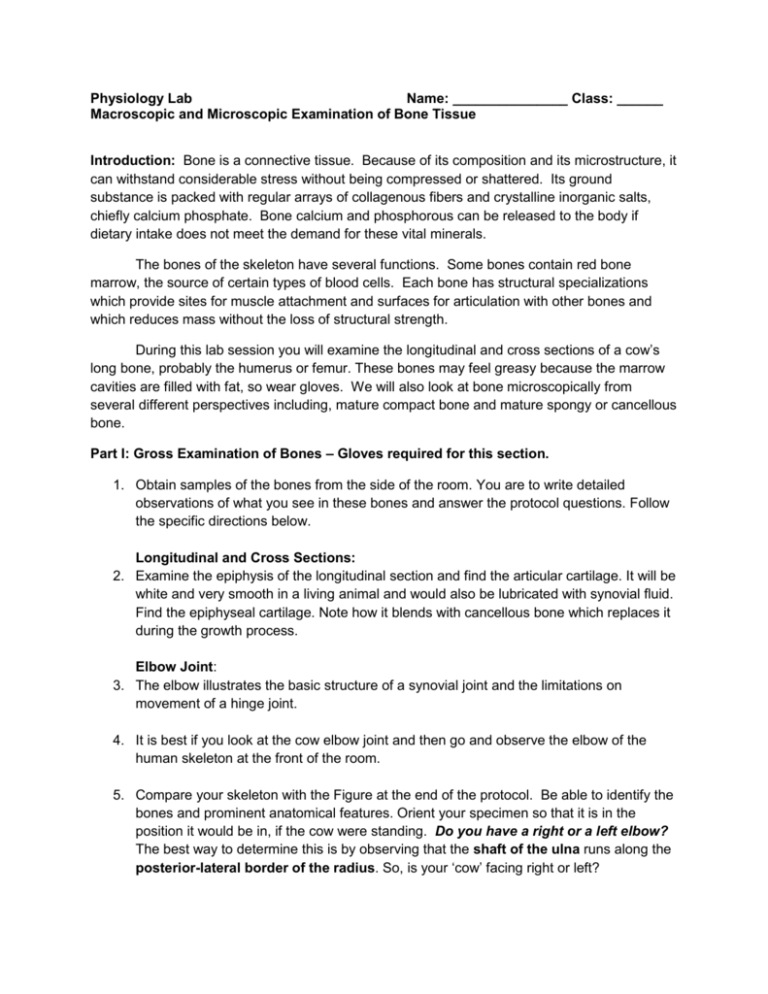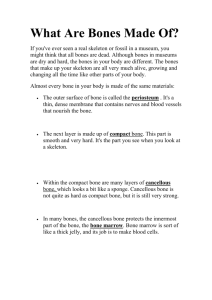Physiology Lab Name: Class: ______ Macroscopic and Microscopic
advertisement

Physiology Lab Name: _______________ Class: ______ Macroscopic and Microscopic Examination of Bone Tissue Introduction: Bone is a connective tissue. Because of its composition and its microstructure, it can withstand considerable stress without being compressed or shattered. Its ground substance is packed with regular arrays of collagenous fibers and crystalline inorganic salts, chiefly calcium phosphate. Bone calcium and phosphorous can be released to the body if dietary intake does not meet the demand for these vital minerals. The bones of the skeleton have several functions. Some bones contain red bone marrow, the source of certain types of blood cells. Each bone has structural specializations which provide sites for muscle attachment and surfaces for articulation with other bones and which reduces mass without the loss of structural strength. During this lab session you will examine the longitudinal and cross sections of a cow’s long bone, probably the humerus or femur. These bones may feel greasy because the marrow cavities are filled with fat, so wear gloves. We will also look at bone microscopically from several different perspectives including, mature compact bone and mature spongy or cancellous bone. Part I: Gross Examination of Bones – Gloves required for this section. 1. Obtain samples of the bones from the side of the room. You are to write detailed observations of what you see in these bones and answer the protocol questions. Follow the specific directions below. Longitudinal and Cross Sections: 2. Examine the epiphysis of the longitudinal section and find the articular cartilage. It will be white and very smooth in a living animal and would also be lubricated with synovial fluid. Find the epiphyseal cartilage. Note how it blends with cancellous bone which replaces it during the growth process. Elbow Joint: 3. The elbow illustrates the basic structure of a synovial joint and the limitations on movement of a hinge joint. 4. It is best if you look at the cow elbow joint and then go and observe the elbow of the human skeleton at the front of the room. 5. Compare your skeleton with the Figure at the end of the protocol. Be able to identify the bones and prominent anatomical features. Orient your specimen so that it is in the position it would be in, if the cow were standing. Do you have a right or a left elbow? The best way to determine this is by observing that the shaft of the ulna runs along the posterior-lateral border of the radius. So, is your ‘cow’ facing right or left? 6. Note that the humerus comes into contact with both the ulna and the radius, but that the distal end of the ulna fuses with the radius. Compare this with the human skeleton at the front of the room. Which arrangement is best for walking on four legs? Why? Which is best for rotating the hand and carrying things? 7. Find the elbow joint. Now extend it. Note that it “locks” into the extended position; this enables the cow to stand with minimal expenditure of energy. Notice that a part of the ulna slips into the notch of the humerus when the joint is extended. This articulation limits the degree to which the elbow joint can be extended. Now look for the ligaments on either side of the humerus and observe how they attach to the ulna and radius. The ligaments prevent the bones of the joint from being dislocated. If the ligaments are damaged by stretching, the condition is called a sprain. 8. When you are done return these bones to the table at the side of the room. Wash the dissecting trays and any tools with lots of soapy water. Dry all the equipment. Next we will examine bones from a microscopic view. Part II: Microscopic Analysis of Bone – Use the Real Anatomy software on your computers to help you identify all the structures underlined for each slide. For each of the types of bone views below, draw a detailed picture labeling all the underlined structures, REMEMBER to also write down 2 bullet points of information from Real Anatomy for each slide. For this lab, only 2 pictures per page. 1. Compact Ground Bone Haversian systems are roughly cylindrical in structures that may branch. The slide you are viewing is a ground section of mature human compact bone. The center of each Haversian system contains a Haversian canal, which travels through its long axis. This is surrounded by concentric layers of rings of mineralized osteoid material, lamellae and a concentric arrangement of lacunae, which house the bone cells, osteocytes. The lacunae appear as dark oval structures. Though osteons vary in size, lacunae are smaller, more numerous and are relatively uniform in size. Canaliculi radiate outwards from the haversian canals to the lacunae, connecting osteocytes to osteocytes, allowing materials to pass from cell to cell. 2. Cancellous (Spongy) Bone Cancellous bone consists mostly of slender, trabeculae/spicules which enclose irregular shaped and sized marrow cavities. At the edges, the trabeculae merge with a very thin shell of compact bone. The trabeculae are composed of parallel lamellae, scattered with osteocytes located in their lacunae. Assessment: 1. Introduction: Research one bone disease, NOT OSTEOPOROSIS, and in 2 paragraphs discuss causes of the disease, how it affects the overall functioning of the skeleton and treatments of the disease. You must include ONE CITATION (not your textbook) for this section!!! Remember, full MLA format, not just the URL! Resource CANNOT be older than 2005 and if no author or date of publication or website update date, then you cannot use the reference! 2. Observations Description of the longitudinal and cross sections of the cow bone and elbow joint you observed – in detail. Remember – oh wow factor!! Answer to questions found in protocol parts 5 and 6. Use full, descriptive sentences. For the two slides you observed today, discuss the how the microscopic structural view relates to the macroscopic structure and overall function on each specific bone type. 3. Labeled bone drawings. There are to be 2 fully labeled drawings + 2 Real Anatomy bullet points per drawing. 4. Analysis Question/Conclusion: Elderly people often break bones under conditions that, for younger people represent normal use. How do you explain for this observation? Minimum of each of the following required: one paragraph long and one citation required. Not your textbook!









